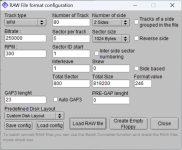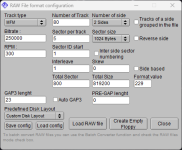Retro Canada
Experienced Member
Well I just built my FDC replica and made my very own CPM bootable floppies with the help of greazeweazle and cpm tools. You can get the HFE and use with HxC2001 or image it to real floppies using the gw or kryoflux. These are the 3.5" with my white over black CP/M, Turbo Pascal and WordStar. I make my own images with a final touch of a real flux track0 on it.
The process is simple, using DD i create an empty floppy image:
for a nab3 (3.5 720KB):
diskdef nab3
seclen 1024
tracks 160
sectrk 5
blocksize 2048
maxdir 384
skew 2
boottrk 1
os 3
end
You use:
dd if=/dev/zero ibs=5K count=160 | tr "\0" "\345" >> new_nab3.dsk
now using cpmcp copy all the files you need. Don't forget cpm3.sys and ccp.com for a bootable.
Then using the HxCSoftware I load the raw image I created as:

Then save it as HFE. Now using greazeweazle you write this entire image to the floppy. And now comes the final touch:
Using greazleweazle again you write just the track0.0.raw from a 3.5 bootable flux, like the one provided by snucci and voila, a bootable disk.
Here attached HFE images with the track0 on it. I re-fluxed the floopies and imported into HxCSoftware again. You can use them to image your floppies or use direct in a hxc2001 floppy.
The process is simple, using DD i create an empty floppy image:
for a nab3 (3.5 720KB):
diskdef nab3
seclen 1024
tracks 160
sectrk 5
blocksize 2048
maxdir 384
skew 2
boottrk 1
os 3
end
You use:
dd if=/dev/zero ibs=5K count=160 | tr "\0" "\345" >> new_nab3.dsk
now using cpmcp copy all the files you need. Don't forget cpm3.sys and ccp.com for a bootable.
Then using the HxCSoftware I load the raw image I created as:

Then save it as HFE. Now using greazeweazle you write this entire image to the floppy. And now comes the final touch:
Using greazleweazle again you write just the track0.0.raw from a 3.5 bootable flux, like the one provided by snucci and voila, a bootable disk.
Here attached HFE images with the track0 on it. I re-fluxed the floopies and imported into HxCSoftware again. You can use them to image your floppies or use direct in a hxc2001 floppy.

